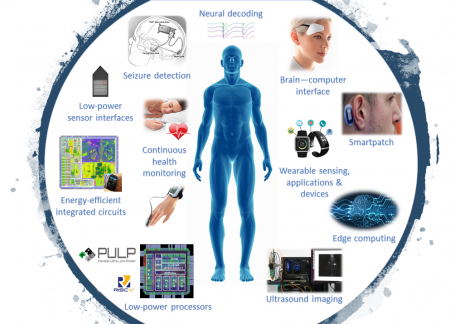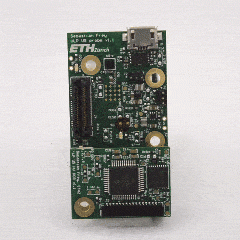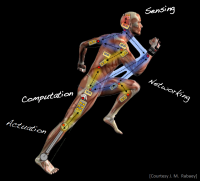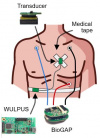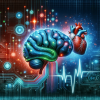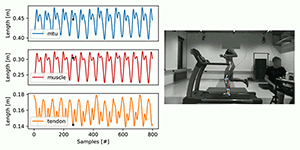Difference between revisions of "Biomedical Circuits, Systems, and Applications"
From iis-projects
(Created page with "=Biomedical Engineering= thumb|right|450px The world around us is getting a lot smarter quickly: virtually every single component of our daily l...") |
|||
| (105 intermediate revisions by 4 users not shown) | |||
| Line 1: | Line 1: | ||
| − | |||
[[File:iis-project-image.png|thumb|right|450px]] | [[File:iis-project-image.png|thumb|right|450px]] | ||
| − | |||
| − | + | Research on biomedical sensing systems and signal processing algorithms has been very prolific in recent years with a variety of solutions in a wide range of application scenarios, for example long-term monitoring of human vital signs for disease detection. Low-power consumption and energy efficiency are the key features of such systems starting from the sensor node for data acquisition, towards embedded systems for data handling, and accurate algorithms for data processing. | |
| − | + | Many research topics are actively ongoing around the human body, from chip design, to system development, to algorithmic investigations in various application scenarios. In the following sections you find links to past and current projects that you might find interesting. | |
| − | + | Don't hesitate to drop us an email! | |
| − | |||
| − | |||
| − | |||
| − | |||
| − | |||
| − | |||
| − | |||
| − | |||
| − | + | =[[Digital Medical Ultrasound Imaging]]= | |
| − | |||
| − | |||
| − | |||
| − | |||
| + | [[File:Wulpus_1v1.gif|thumb|left|240px|Wearable ultrasound]] | ||
| + | [[File:US_probes.jpg|thumb|right|400px|IIS Ultrasound Imaging Probes]] | ||
| − | + | Ultrasound is one of the most used medical imaging modalities. Its main features are: real-time operation, low-cost, wide-availability, excellent spatial and time resolution, low-power. Recently, multiple innovative systems are being developed, targeting both high-end and wearable/embedded applications. | |
| − | |||
| − | |||
| − | |||
| − | = | + | At IIS, we are exploring the next generation of medical ultrasound imaging systems, spanning from very high-end systems (FPGA-based digital probes with >100 channels and ultra high-speed Gb/s interfaces), to wearable wireless systems (FPGA or MCU-based, equipped with WiFi or Bluetooth links). |
| − | + | ||
| − | + | More information can be found [[Digital_Medical_Ultrasound_Imaging|here]]. | |
| − | + | ||
| − | + | ||
| − | + | ||
| − | + | ||
| + | |||
| + | |||
| + | |||
| + | |||
| + | |||
| + | |||
| + | |||
| + | |||
| + | =[[Flexible Electronic Systems and Embedded Epidermal Devices]]= | ||
| + | [[File:ustemg.jpg|thumb|left|120px| Ultrasound Transparent EMG System]] | ||
| + | |||
| + | Flexible Electronic Systems use polymers and other flexible or stretchable materials to create wearable and conformable devices. These systems consist of various components, including flexible and bendable parts, such as electrodes and transducers, as well as small rigid components, such as energy storage units, transistors, and complete integrated circuits (ICs). The design of these systems allows for comfortable wear, as they can be positioned close to or even attached to the human body as epidermal devices. The integration of digital electronic components enables these devices to perform complex functions, such as continuous monitoring and modulation of physiological signals and communication with other devices. | ||
| + | |||
| + | However, the development of such systems is faced with several challenges. These challenges include material properties, such as flexibility, stretchability, and biocompatibility, as well as reliability issues due to bending and mechanical stress on the entire hardware and signal stack, and interface challenges at all levels of integration. Advanced and specialized manufacturing techniques are also required for their fabrication. Our research focuses on improving the interconnectivity and processing reliability of digital circuits on flexible, stretchable substrates. This helps to bring hardware intelligence closer to the skin surface, and we also develop smart embedded solutions to optimize the manufacturing process. | ||
| + | |||
| + | |||
| + | More information can be found [[Flexible Electronic Systems and Embedded Epidermal Devices|here]]. | ||
| + | |||
| + | |||
| + | |||
| + | |||
| + | |||
| + | |||
| + | |||
| + | |||
| + | =[[Human Intranet | Human Intranet: wearables and algorithms for health and human-machine interfaces]]= | ||
| + | |||
| + | [[File:HI.png|thumb|right|200px]] | ||
| + | |||
| + | Human Intranet is an open, scalable platform that seamlessly integrates an ever-increasing number of sensor, actuation, computation, storage, communication and energy nodes located on, in, or around the human body acting in symbiosis with the functions provided by the body itself. Human Intranet presents a system vision in which, for example, disease would be treated by chronically measuring biosignals deep in the body, or by providing targeted, therapeutic interventions that respond on demand and in situ. | ||
| + | |||
| + | In the following, a summary of the main projects is given. More details can be found [[Human_Intranet|here]]. | ||
| + | |||
| + | |||
| + | ===[[Human_Intranet#Wearables_for_health_and_physiology | Wearables for Health and Physiology]] === | ||
| + | |||
| + | [[File:Cardiorespiratory.JPG|thumb|left|100px]] | ||
| + | |||
| + | In this research area, we develop wearable systems, algorithms, and applications for monitoring health- and physiological-related parameters in innovative ways. Example applications include (but are not limited to): heart rate and respiration rate monitoring, blood pressure monitoring, bladder monitoring, drowsiness detection, monitoring of muscle contractions and identification of innervations, ... | ||
| + | Example devices include (but are not limited to): smart patches, smart glasses, smart earbuds, ... | ||
| + | |||
| + | |||
| + | |||
| + | |||
| + | |||
| + | |||
| + | ===[[Human_Intranet#Brain-Machine_Interfaces_and_wearables | Brain-Machine Interfaces]] === | ||
| + | |||
| + | [[File:Emotiv-epoc-14-channel-mobile-eeg.jpg|thumb|left|100px]] | ||
| + | |||
| + | Noninvasive brain–machine interfaces (BMIs) and neuroprostheses aim to provide a communication and control channel based on the recognition of the subject’s intentions from spatiotemporal neural activity typically recorded by EEG electrodes. | ||
| + | |||
| + | In these projects, our goal is to develop efficient devices and algorithms that replace traditional signal processing and classification methods by directly operating with raw data from electrodes. Furthermore, we aim to efficiently deploy those algorithms on tightly resource-limited devices (e.g., Microcontroller units) for near sensor classification using artificial intelligence. | ||
| + | Example use cases include (but are not limited to): smart glasses, smart earbuds, smart headbands... | ||
| + | |||
| + | |||
| + | |||
| + | ===[[Human_Intranet#Epilepsy_Seizure_Detection_Device | Epilepsy Seizure Detection Devices and Algorithms]] === | ||
| + | |||
| + | [[File:NeuroPace.jpg|thumb|left|100px]] | ||
| + | |||
| + | Epilepsy is a brain disease that affects more than 50 million people worldwide. Conventional treatments are primarily pharmacological, but they can require surgery or invasive neurostimulation in the case of drug-resistant subjects. In these cases, personalized patient treatments are necessary and can be achieved with the help of long-term recording of brain activity. In this context, seizure detection systems hold promise for improving the quality of life for patients with epilepsy, providing non-stigmatizing and reliable continuous monitoring during real-life conditions. In this project, our goal is to develop efficient techniques for EEG as well as non-EEG signals to detect an upcoming seizure in an ultra-low-power device. | ||
| + | |||
| + | |||
| + | ===[[Human_Intranet#Foundation_models_and_LLMs_for_Health | Foundation models and LLMs for Health]] === | ||
| + | [[File:EEG_ECG.png|thumb|left|100px]] | ||
| + | Incorporating Foundation Models and Large Language Models (LLMs) within artificial intelligence is gaining significant traction, particularly due to their potential applications in the health sector. This project is dedicated to developing sophisticated methodologies for utilizing foundation models and LLMs in health-related applications, specifically analyzing electroencephalogram (EEG) brain signals. In healthcare and biomedical research, implementing advanced computational models, notably Foundation Models and Large Language Models (LLMs), revolutionizes the understanding and interpretation of intricate biosignals. We stand at the vanguard of this revolutionary change, delving into the capabilities of these models for the analysis and interpretation of critical biosignals, including electroencephalograms (EEG) and electrocardiograms (ECG). | ||
| + | |||
| + | |||
| + | |||
| + | |||
| + | |||
| + | |||
| + | =[[Wearables for Sports and Fitness Tracking]]= | ||
| + | [[File:running_small.gif|right]] | ||
| + | |||
| + | The popularity of wearable technology is growing rapidly in the sports and fitness industry. With fitness trackers and smartwatches, it's easy to monitor key metrics like heart rate, steps, and calories burned, which helps users reach fitness goals and participate in online challenges. These devices can even create personalized training programs based on data collected. Wearables also give athletes real-time feedback on performance and technique to improve competitive skills and coaches new opportunities to monitor and analyze training data for better management. Furthermore, wearable technology can be used for rehabilitation and managing chronic conditions such as chronic pain, providing patients with the necessary information to make informed decisions about their treatment. | ||
| + | |||
| + | More information can be found [[Wearables_for_Sports_and_Fitness_Tracking | here]]. | ||
| + | |||
| + | <!-- =[http://iis-projects.ee.ethz.ch/index.php?title=Biomedical_System_on_Chips Biomedical System on Chips]= | ||
| + | |||
| + | Every human and animal body generates a large and steady amount of data as consequence of several underlying life-long processes, e.g., respiration, vascular system dynamic, muscle contraction. By acquiring and processing these vital signals, usually by electrical or optical means, substantial amount of information can be extracted, enabling sense-making being used to take informative decisions. Successful application examples range from commercial fitness-tracker gadgets to medical-grade devices that enables tele-health remote medicine, as well as edge-cutting scientific research on living biological models. | ||
| + | |||
| + | It is a joint effort between the Analog and Mixed Signal and Digital Design Groups. More info [[Biomedical_System_on_Chips|here]]. --> | ||
| + | |||
| + | |||
| + | |||
| + | [[Category:Digital]] | ||
| + | [[Category:Human Intranet]] | ||
| + | [[Category:Semester Thesis]] | ||
| + | [[Category:Master Thesis]] | ||
Latest revision as of 19:16, 23 March 2024
Research on biomedical sensing systems and signal processing algorithms has been very prolific in recent years with a variety of solutions in a wide range of application scenarios, for example long-term monitoring of human vital signs for disease detection. Low-power consumption and energy efficiency are the key features of such systems starting from the sensor node for data acquisition, towards embedded systems for data handling, and accurate algorithms for data processing.
Many research topics are actively ongoing around the human body, from chip design, to system development, to algorithmic investigations in various application scenarios. In the following sections you find links to past and current projects that you might find interesting.
Don't hesitate to drop us an email!
Contents
Digital Medical Ultrasound Imaging
Ultrasound is one of the most used medical imaging modalities. Its main features are: real-time operation, low-cost, wide-availability, excellent spatial and time resolution, low-power. Recently, multiple innovative systems are being developed, targeting both high-end and wearable/embedded applications.
At IIS, we are exploring the next generation of medical ultrasound imaging systems, spanning from very high-end systems (FPGA-based digital probes with >100 channels and ultra high-speed Gb/s interfaces), to wearable wireless systems (FPGA or MCU-based, equipped with WiFi or Bluetooth links).
More information can be found here.
Flexible Electronic Systems and Embedded Epidermal Devices
Flexible Electronic Systems use polymers and other flexible or stretchable materials to create wearable and conformable devices. These systems consist of various components, including flexible and bendable parts, such as electrodes and transducers, as well as small rigid components, such as energy storage units, transistors, and complete integrated circuits (ICs). The design of these systems allows for comfortable wear, as they can be positioned close to or even attached to the human body as epidermal devices. The integration of digital electronic components enables these devices to perform complex functions, such as continuous monitoring and modulation of physiological signals and communication with other devices.
However, the development of such systems is faced with several challenges. These challenges include material properties, such as flexibility, stretchability, and biocompatibility, as well as reliability issues due to bending and mechanical stress on the entire hardware and signal stack, and interface challenges at all levels of integration. Advanced and specialized manufacturing techniques are also required for their fabrication. Our research focuses on improving the interconnectivity and processing reliability of digital circuits on flexible, stretchable substrates. This helps to bring hardware intelligence closer to the skin surface, and we also develop smart embedded solutions to optimize the manufacturing process.
More information can be found here.
Human Intranet: wearables and algorithms for health and human-machine interfaces
Human Intranet is an open, scalable platform that seamlessly integrates an ever-increasing number of sensor, actuation, computation, storage, communication and energy nodes located on, in, or around the human body acting in symbiosis with the functions provided by the body itself. Human Intranet presents a system vision in which, for example, disease would be treated by chronically measuring biosignals deep in the body, or by providing targeted, therapeutic interventions that respond on demand and in situ.
In the following, a summary of the main projects is given. More details can be found here.
Wearables for Health and Physiology
In this research area, we develop wearable systems, algorithms, and applications for monitoring health- and physiological-related parameters in innovative ways. Example applications include (but are not limited to): heart rate and respiration rate monitoring, blood pressure monitoring, bladder monitoring, drowsiness detection, monitoring of muscle contractions and identification of innervations, ... Example devices include (but are not limited to): smart patches, smart glasses, smart earbuds, ...
Brain-Machine Interfaces
Noninvasive brain–machine interfaces (BMIs) and neuroprostheses aim to provide a communication and control channel based on the recognition of the subject’s intentions from spatiotemporal neural activity typically recorded by EEG electrodes.
In these projects, our goal is to develop efficient devices and algorithms that replace traditional signal processing and classification methods by directly operating with raw data from electrodes. Furthermore, we aim to efficiently deploy those algorithms on tightly resource-limited devices (e.g., Microcontroller units) for near sensor classification using artificial intelligence. Example use cases include (but are not limited to): smart glasses, smart earbuds, smart headbands...
Epilepsy Seizure Detection Devices and Algorithms
Epilepsy is a brain disease that affects more than 50 million people worldwide. Conventional treatments are primarily pharmacological, but they can require surgery or invasive neurostimulation in the case of drug-resistant subjects. In these cases, personalized patient treatments are necessary and can be achieved with the help of long-term recording of brain activity. In this context, seizure detection systems hold promise for improving the quality of life for patients with epilepsy, providing non-stigmatizing and reliable continuous monitoring during real-life conditions. In this project, our goal is to develop efficient techniques for EEG as well as non-EEG signals to detect an upcoming seizure in an ultra-low-power device.
Foundation models and LLMs for Health
Incorporating Foundation Models and Large Language Models (LLMs) within artificial intelligence is gaining significant traction, particularly due to their potential applications in the health sector. This project is dedicated to developing sophisticated methodologies for utilizing foundation models and LLMs in health-related applications, specifically analyzing electroencephalogram (EEG) brain signals. In healthcare and biomedical research, implementing advanced computational models, notably Foundation Models and Large Language Models (LLMs), revolutionizes the understanding and interpretation of intricate biosignals. We stand at the vanguard of this revolutionary change, delving into the capabilities of these models for the analysis and interpretation of critical biosignals, including electroencephalograms (EEG) and electrocardiograms (ECG).
Wearables for Sports and Fitness Tracking
The popularity of wearable technology is growing rapidly in the sports and fitness industry. With fitness trackers and smartwatches, it's easy to monitor key metrics like heart rate, steps, and calories burned, which helps users reach fitness goals and participate in online challenges. These devices can even create personalized training programs based on data collected. Wearables also give athletes real-time feedback on performance and technique to improve competitive skills and coaches new opportunities to monitor and analyze training data for better management. Furthermore, wearable technology can be used for rehabilitation and managing chronic conditions such as chronic pain, providing patients with the necessary information to make informed decisions about their treatment.
More information can be found here.
